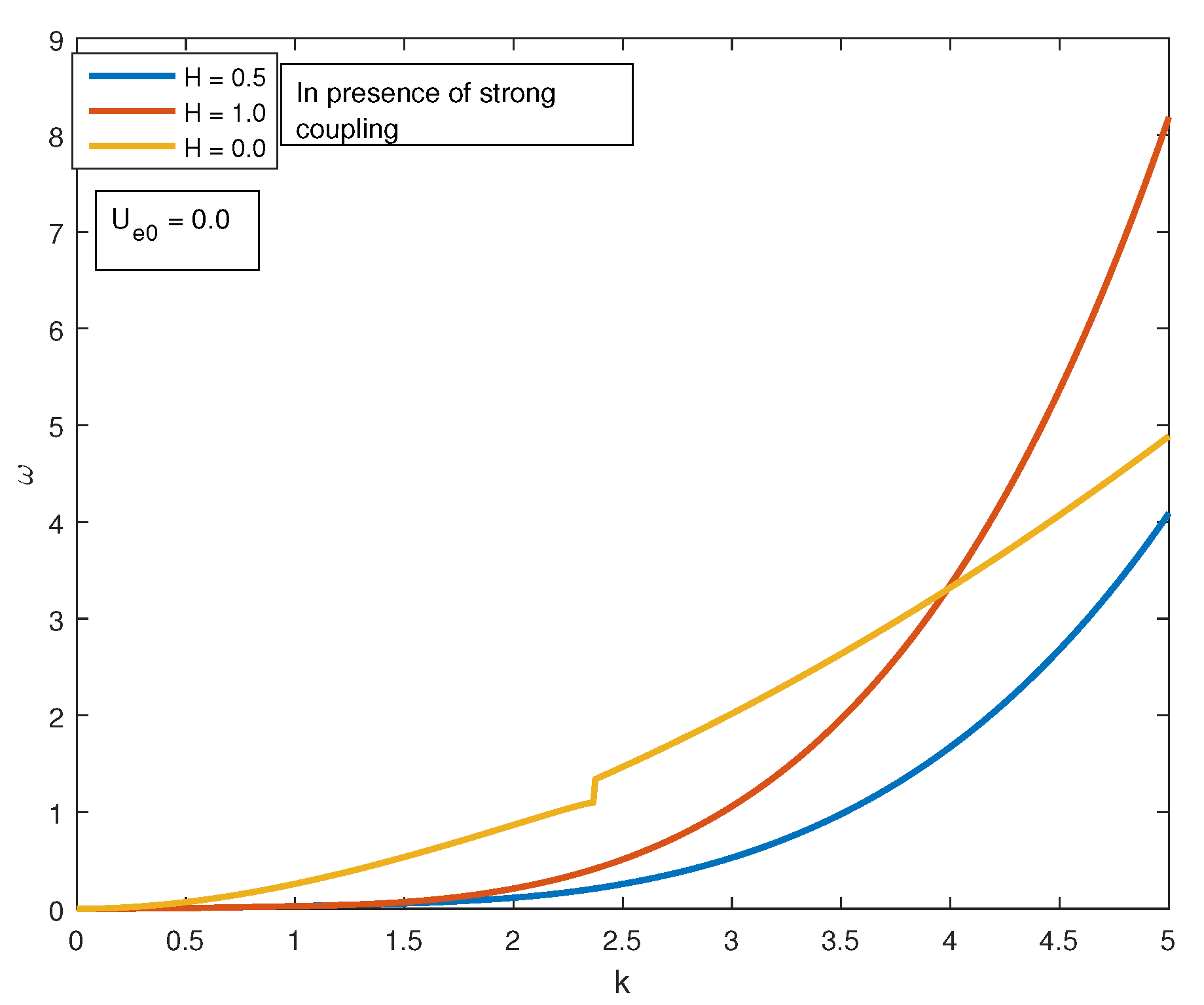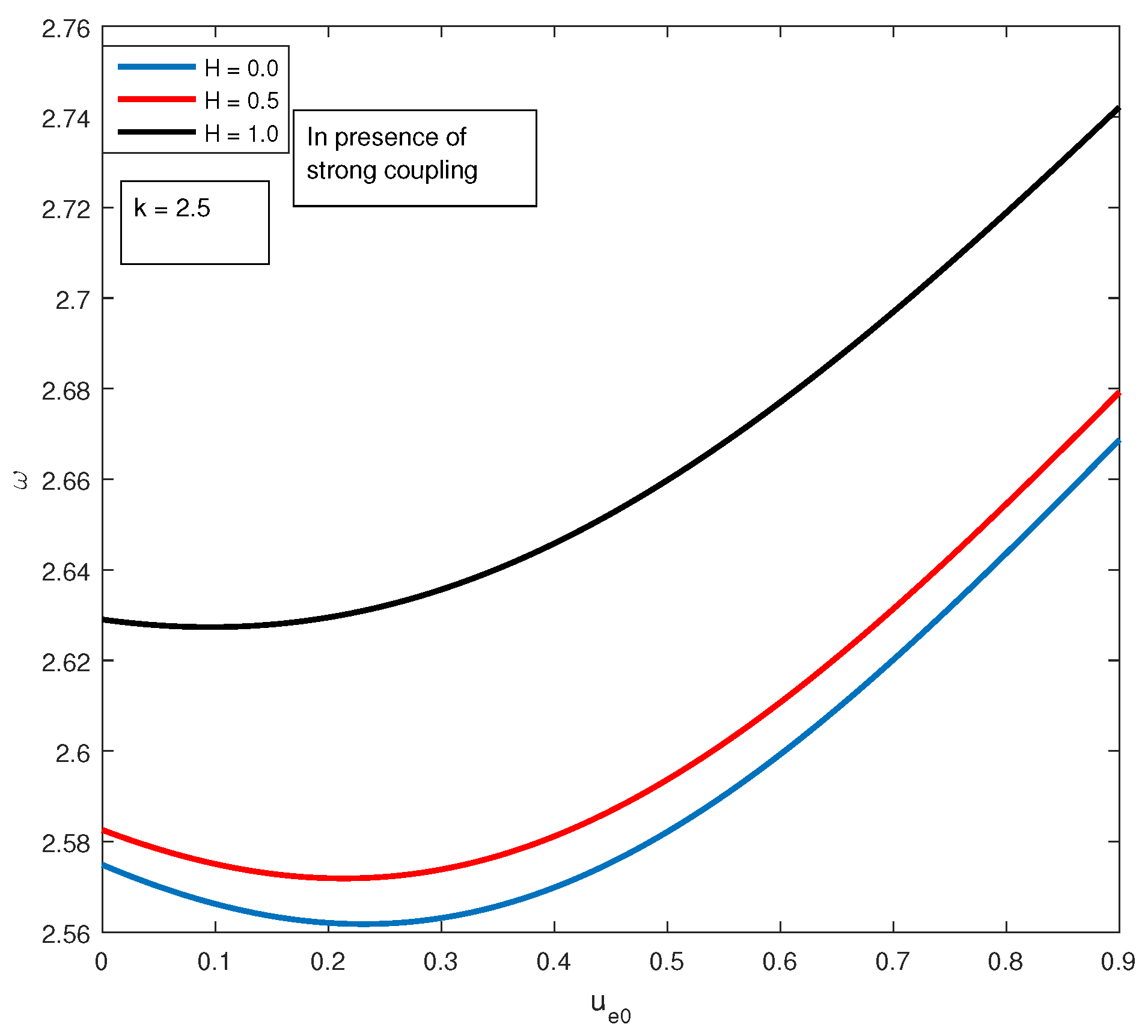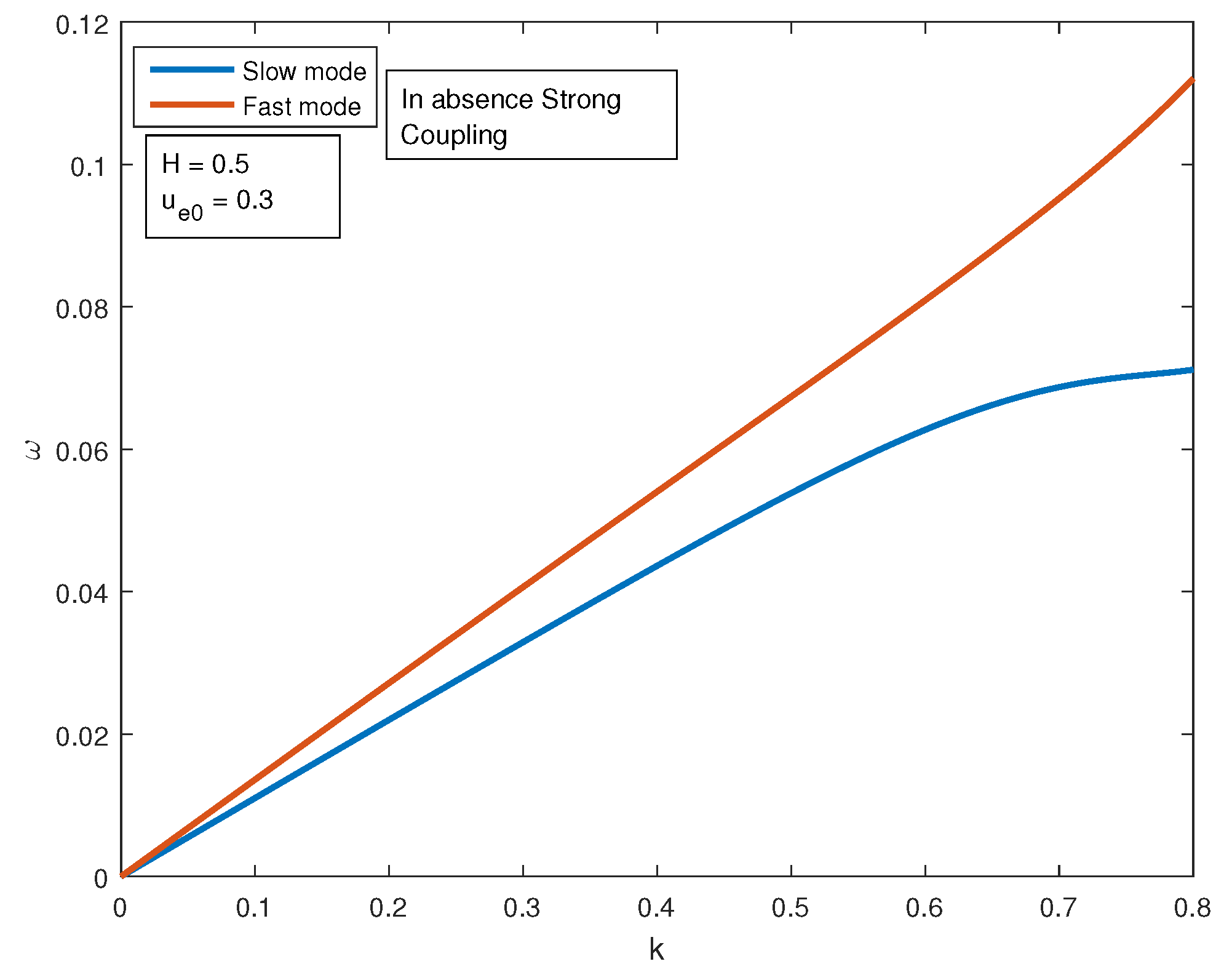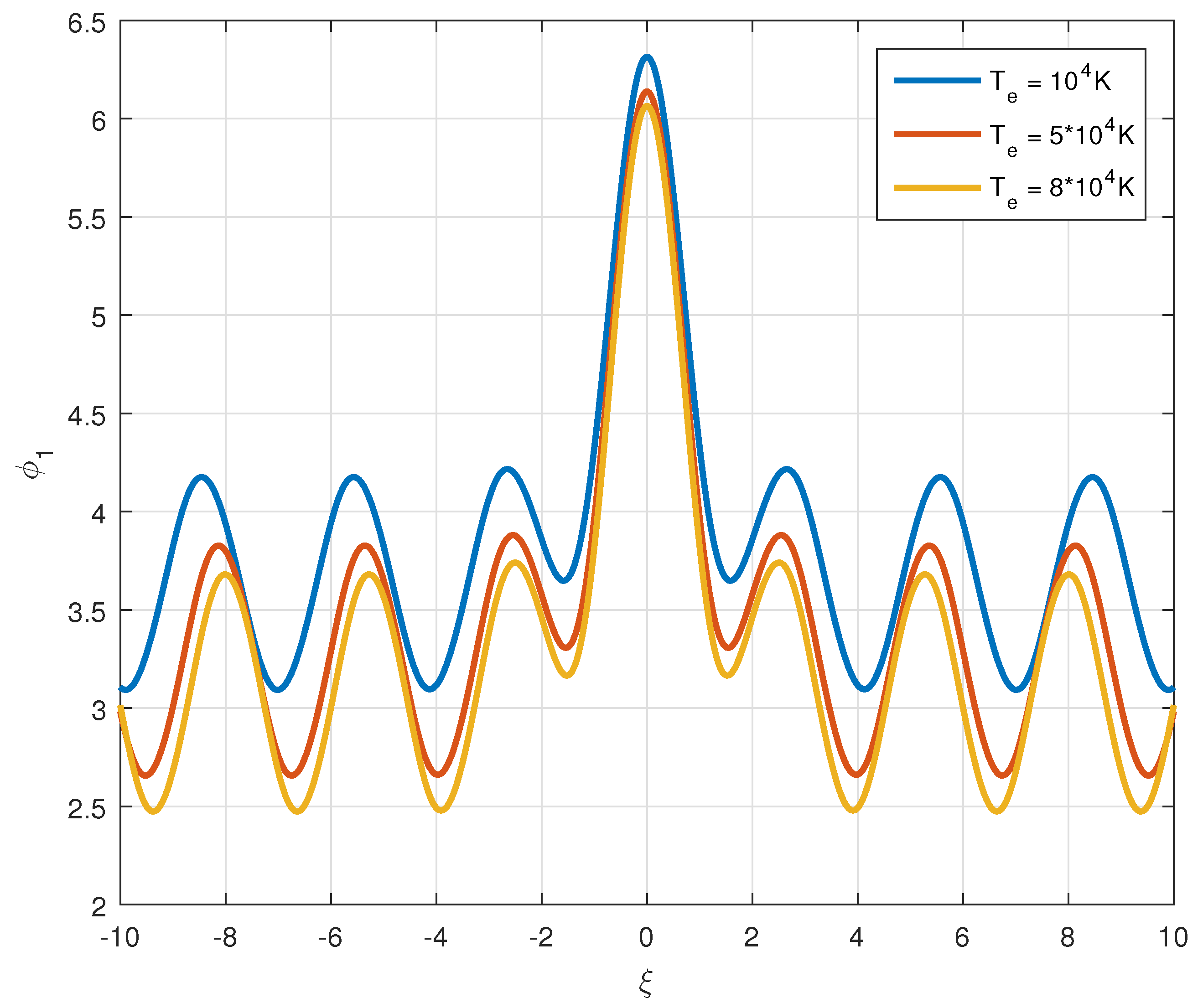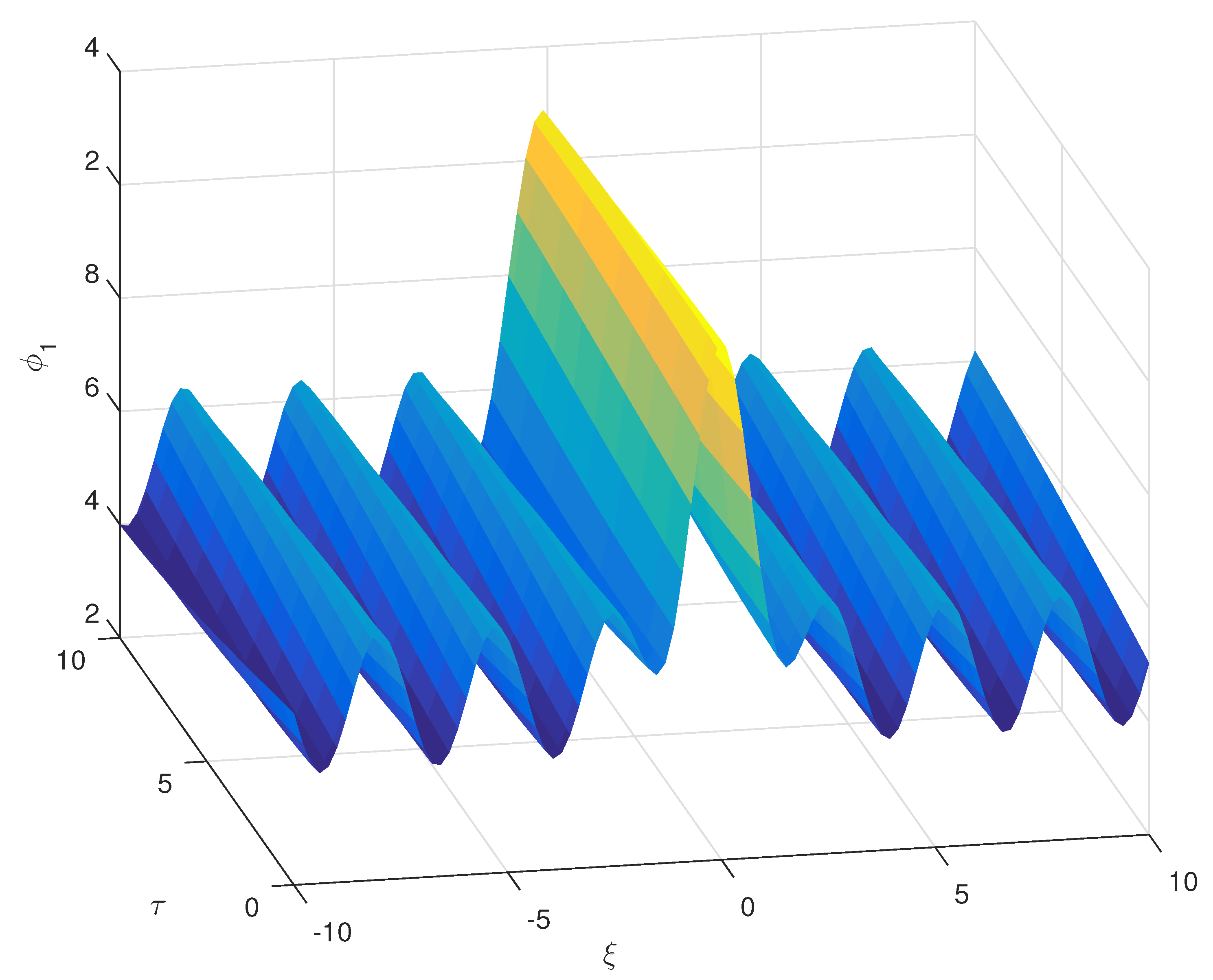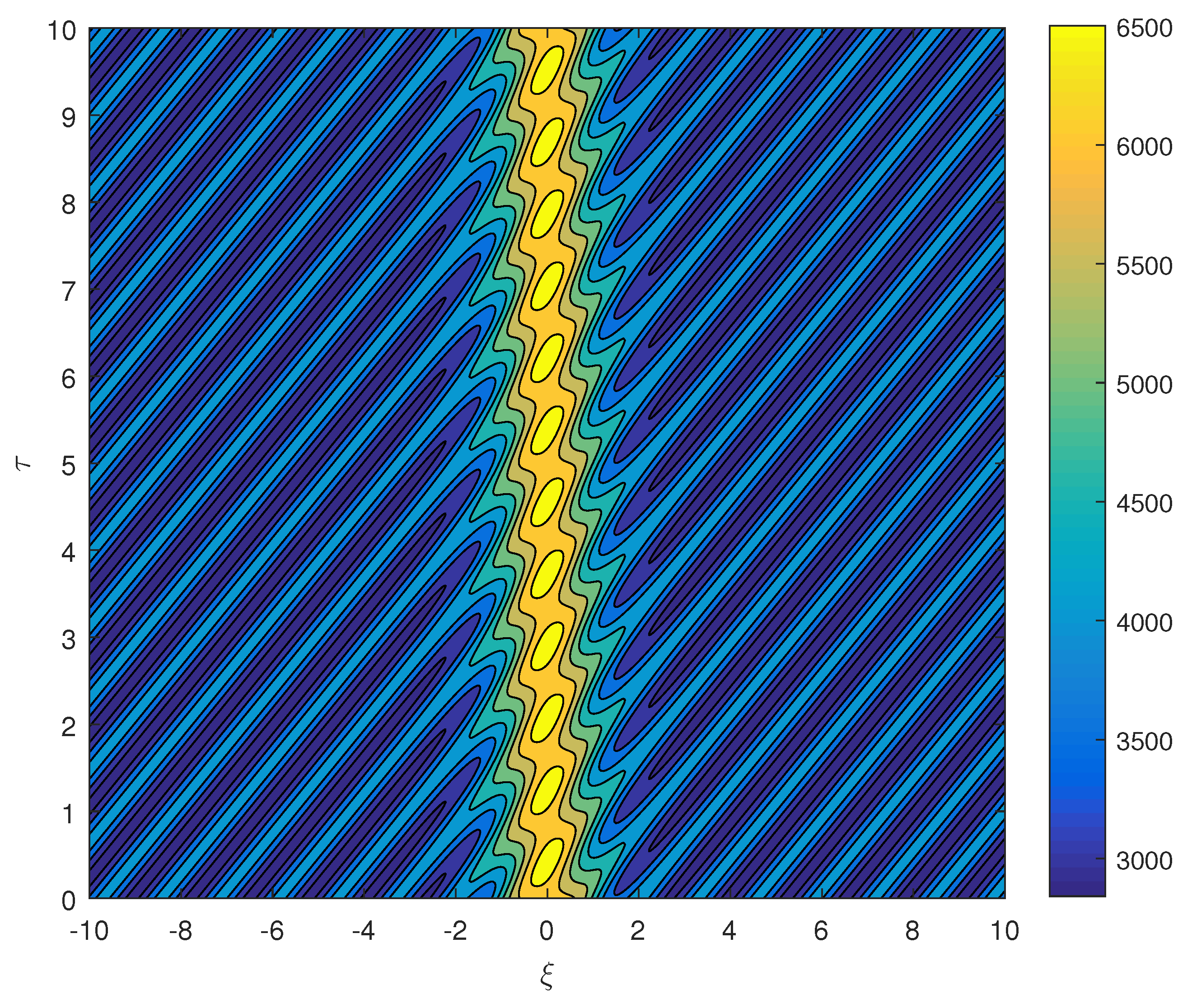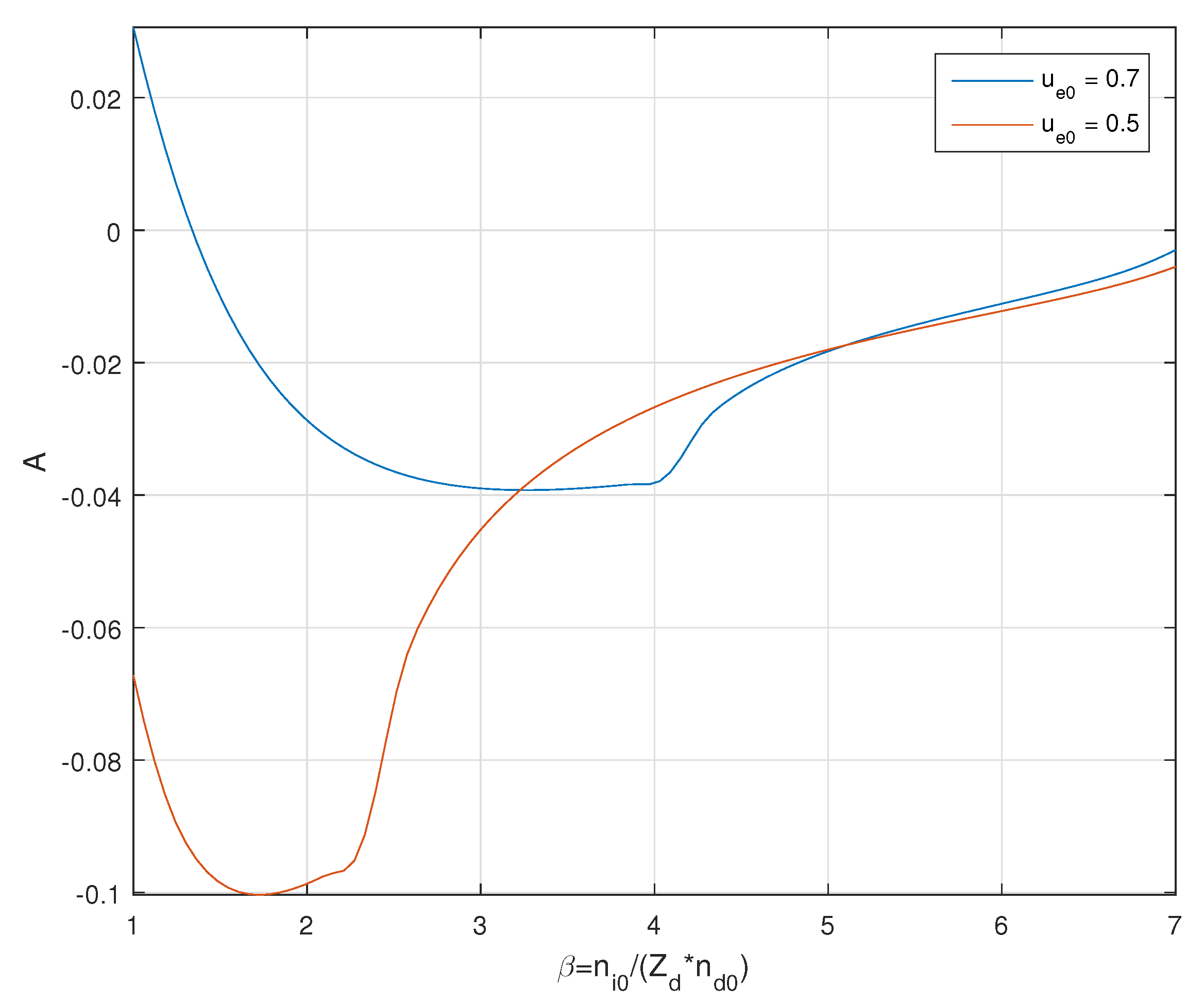1. Introduction
The interest in study of plasmas containing dust particles are growing day by day, because of the importance of such plasmas in the study of the space environment, such as asteroid zones, planetary rings, cometary tails as well as lower ionosphere of earth. The dust-in-plasma or the dusty plasma contain dust grains, which has a dimension of the order of micrometer to sub-micrometer [
1,
2,
3].
Quantum aspects of plasma gained importance in recent times due to its application in plasma echoes [
4] and micro-electronic devices [
5]. Initially the subject was formulated and studied by Haas [
6] and his collaborators [
7]. It has applications in Fermi gas [
8], quantum Penrose diagrams and quantum plasma instabilities [
9]. Moreover, the quantum hydrodynamic model deals only with the macroscopic variables, namely the density and velocity stress tensors, etc., and also includes the so called Bohm potential [
10]. On the other hand a different approach of quantum plasma is that of Wigner-Poisson equation, which is actually a kinetic model [
11]. However, it is less effective in numerical simulations compared to that of the Q.H.D. (Quantum Hydrodynamic Model).
Actually, the field of quantum plasma physics has a long and diverse tradition and is garnering increasing interest that is motivated by its potential applications in modern technology. The quantum degeneracy effects start playing a significant role when the de Broglie thermal wavelength for electrons is similar to or larger than the average interelectron distance ‘’. Moreover, one can show that when the temperature approaches the electron Fermi temperature , the equilibrium distribution function changes from the Maxwell–Boltzmann to the Fermi–Dirac one.
Another important domain of present day plasma physics is the study of dusty plasma [
12], and thus many analyses have been performed on quantum dusty plasma [
13,
14]. The emergence of the dust acoustic wave (D.A.W) is an important aspect of such analysis [
15]. Dust Acoustic Waves (DAW) have been discussed in connection with various structures that have been observed in Saturn rings, such as spokes, braids and clumps [
16]. The study of quantum plasma has been extensively performed by Haas [
17], Shukla [
18] and many others. However, in the domain of dusty plasma, the important phenomenon is of strong coupling of dust particles [
19]. The corresponding investigation has been performed at least in two main formulations: one is to use the visco-elastic model [
20] and the other by using effective electrostatic pressure [
21]. It was Ikezi [
22] who predicted that a dusty plasma can enter the strong coupling regime due to high charge and low temperature of the dust that makes the coupling co-efficient
, and the coupling co-efficient
is the ratio between the Coulomb potential energy and thermal energy used to measure the relative importance of these electrostatic forces on the dust grain. Here ‘
’, ‘
’ and ‘
’ are the temperature, charge number and mean inter-particle distance of the dust, respectively. The equation of the state of strongly coupled plasma was formulated by Cousens et al. [
23] and written as
, the effective electrostatic pressure. ‘
’ is the effective electrostatic temperature defined as
where ‘
’ is the number of nearest neighbors determined by the normalized inter-particle distance.
On the other-hand, quantum dusty plasma [
22] is well known as the feature of high charge and low temperature of dust grains with high number density compared with that of classical plasma, which renders the existence of strongly coupled regimes appearing in quantum plasma possible.
In the first part, we analyzed the linear mode of propagation by starting with the normalized electron-dust-ion equation, where we have assumed that the electrons possess a streaming velocity. The immediate consequence is that we obtain a fast and slow mode of propagation in the dusty plasma. In the next section we applied the reductive perturbation scheme in order to deduce the KdV equation, and it is found that we have a new kind of nonlinear excitation, which is a soliton having a periodic tail. In the next part, we consider the critical case when the nonlinearity coefficient tends to zero and the usual modification of the reductive computation results in the MKdV situation. Such an equation is also observed to posses a cnoidal-type soliton.
2. Formulation
Let us consider a plasma where ‘
’ is the electron density, ‘
’ is the corresponding velocity and the same quantities for the dust particle are denoted as ‘
’, ‘
’. The mass of electron and dust are denoted as ‘
’, ‘
’ respectively. If these are in motion then there will be an electrostatic potential ‘
’ and pressure ‘
’. The Quantum Hydrodynamic (QHD) equations are as follows:
‘
’ is the electrostatic potential here. Moreover, we consider the ions to be immobile and to have a distribution of the following form.
The normalized set of equation governing the dusty plasma can be written as follows:
where the normalized distribution for the background ions is as follows
with
,
and
where ‘
’ and ‘
’ are, respectively, the ion-electron equilibrium densities, and ‘
’ and ‘
’ are their temperatures with
, where we have used all the scaled variables. Here ‘
’ and ‘
’ are the velocity and density of electrons, ‘
’, ‘
’ are those of the dust grains and ‘
’ is the electrostatic potential. The strong interaction between the dust grains are expressed as a force given by the potential.
The normalized variables are defined as ; ; ; ; ; ; and , where ; ; and .
3. Linear Propagation and Streaming
In order to analyse the linear propagation mode, we set the following:
where
(from Reference [
23]) provided that, at equilibrium,
. Linearizing the set (
7)–(
12) results in the following.
These relations along with the equilibrium condition results in the following dispersion relation.
Equation (
19) can also be written as follows:
where
;
;
;
.
We also have the following: ; ; ; ; .
The solution of the quartic Equation (
20) is as follows:
where the following is the case.
; ; ; ; ; ;
From the equation set (
21), one can observe that ‘
’ and ‘
’ are physically admissible of the one that gives the slow mode and the other that gives the fast mode. In order to obtain an idea of the physical situation, we have graphically plotted the linear dispersion relation in
Figure 1,
Figure 2,
Figure 3,
Figure 4,
Figure 5,
Figure 6,
Figure 7 and
Figure 8. In
Figure 1 we show the case where there is no streaming or ‘
’ and the effect of strong coupling is also absent, while in
Figure 2 we have shown the situation where there is no streaming but the strong coupling effect is present and as a result the nature of variation of the dispersion relation changes. Moreover due to the presence of strong coupling the wave frequency also gets increased.
One should note that in both the
Figure 1 and
Figure 2, we observe that the quantum diffraction parameter ‘
H’ has a very prominent effect. Next, in the
Figure 3 and
Figure 4, we have shown the variation of the wave frequency with the streaming velocity ‘
’ both in the presence and absence of strong coupling effect.
In the
Figure 5,
Figure 6,
Figure 7 and
Figure 8, we show how the electron streaming gives rise to two modes, namely ‘
slow’ and ‘
fast’, and how they vary with the diffraction parameter ‘H’, streaming velocity ‘
’ and the effect of strong coupling.
4. Reductive Perturbation Approach and the Derivation of the Kdv Equation
In order to analyze the nonlinear propagating mode of the system, we adapt the reductive approach and set the following:
along with
whence in lowest order of
we obtain the following.
This results in the dispersion relation for the long wavelength situation.
In the next order of
, that is, from the terms of
, we obtain the following:
If we eliminate all higher order terms, we obtain the KdV equation:
with
and
, where ‘
’, ‘
’ and ‘
’ are given in
Appendix A. The expression of ‘
’ in Equation (
29) is given by
, where the constants
and
, etc., are given as per Reference [
23].
4.1. Soliton Cnoidal Wave Solution
It is well known that the KdV-equation wrote above always supports stationary wave solutions. However, recent studies have revealed a whole new class of solutions for the KdV problem. It may be mentioned that Boyd observed that one can numerically obtain a new class of solutions that does not follow the definition of soliton in the very strict sense, which is in the sense that it has a long tail that is a periodic waveform. Such novel kinds of patterns are named the ‘nanopteron’ solitons. These are a wide class known as the quasi-soliton. Later on, it was found that one can obtain the analytic form of such a solution by using the famous ‘tanh’-expansion method.
Let us set the following:
where,
,
,
and
w are functions of
to be determined. By substituting Equation (
36) in (
35) and equating various powers of
, a system of over-determined equations are obtained. It is really interesting to note that all these are consistent with one another. Finally, one obtains
and
:
along with the fact that
satisfies the following.
This
is a constant of integration. This last equation actually possesses a wide variety of solutions of which we only consider the following one:
with the following.
‘
’ is the Jacobi-elliptic function with ellipticity ‘
m’. It is interesting to note that ‘
’ and ‘
’ are the velocities of the soliton and the surrounding cnoidal wave. Thus, we can finally write the solution for
:
with the following.
It is now interesting to observe that for
kg;
kg;
kg;
;
;
11,600 kelvin;
kelvin;
kelvin;
kelvin;
;
;
m = 0.04;
; and
;
, the form of
if plotted against
turns out to be of the form given in
Figure 9.
One may note that here we have a central solitary profile, but its tails are not approaching zero in either direction of
. Instead, we have purely sinusoidal behaviour such as
. We have shown how the form changes with the electron temperature
. On the other-hand, if one has
, then we obtain the purely solitary wave, as shown in the
Figure 10.
Moreover, in the
Figure 11 we show the three dimensional form of this new wave form. Lastly, in
Figure 12, we show a contour plot of
where the ordinate is time ‘
’ and the abscissa is ‘
’ for different parameter values.
5. Critical Nonlinearity and MKdv Equation
In the KdV equation derived in Equation (
31) of
Section 4, the nonlinear coefficient ‘
A’ can vanish depending on the values of various parameters. In order to analyze this, we have plotted the form of ‘
A’ as a function of
depending on various values of the electron streaming velocities. In
Figure 13 we have depicted this situation, where it is observed that, in presence of strong coupling,
A can vanish for a particular situation.
In order to analyze such situations, we set the following.
Since all the first order quantities remain the same. We only quote the second order and higher order perturbed quantities.
which provides the following.
However, from the next higher order terms in
, we obtain the following:
from which we can deduce
which when
, it reduces to the M-KdV equation. The expression of the variable ‘
’ in Equation (
48) is given as per Reference [
24]. It is well known that the M-KdV equation also supports soliton solutions. However, here we found a new type of solution that is both solitonic and periodic in nature. For that we set the following:
where
. The second step is to choose
as follows:
where
,
are constants to be determined and
can be obtained as a solution of the following.
Several solutions of (
53) are given in Reference [
17], from which we have the following:
where
.
On the other hand, for
, we can obtain the following.
Here, ‘
’ is the Jacobi elliptic Cosine function,
, where
A and
are given in
Appendix A, and
and
are given after Equation (
44). A diagrammatic representation of
is given in
Figure 14, while the graphical representation of the solution of Equation (
54) is given in
Figure 15 and
Figure 16, which shows both a soliton and periodic behaviour. We have the used the same plasma parameters as in
Section 4.1 for plotting these figures too.

